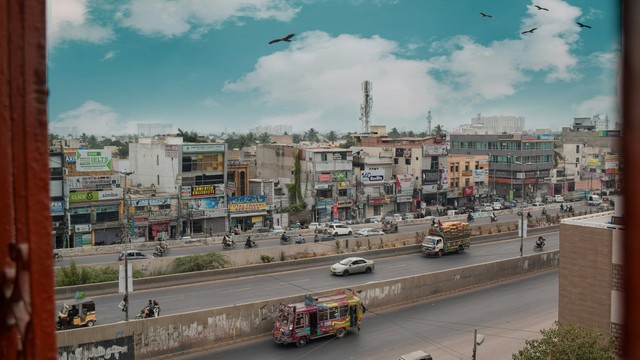Reframing food security for an urbanising world
Achieving the Sustainable Development Goal of zero hunger by 2030 means taking account of changes in both rural and urban contexts. Cecilia Tacoli reports back from a workshop organised with IFAD on some of the issues raised.


Madizini in Tanzania grew from a village into an urban centre, initially because the local sugarcane plantations and factory needed workers. Now the town supports a wide array of businesses (Photo: Copyright Jytte Agergaard)
Achieving food security and improved nutrition is central in current global development agendas and debates. Sustainable Development Goal 2 (SDG 2) aims to achieve zero hunger by 2030. But this is unlikely unless the close interconnections with other SDGs are explicitly identified and embedded in policies.
In March, researchers from African, Asian and international agencies met at a technical workshop co-organised by IIED and IFAD to reflect on the nature and diversity of urbanisation processes and rural-urban linkages, their impacts on food systems and what this means for achieving food security and adequate nutrition for the urban and rural poor.
Food systems do not exist in a vacuum
The way we talk about food security and nutrition has changed considerably in the last decade. This reflects major changes in where people live and what they do. With the majority of people now living in urban centres and with farming accounting for a declining proportion of rural households' incomes, effectively there are now more consumers than producers of food.
At the same time, the links between rural and urban areas, people and enterprises have intensified. The physical movement of goods, people, money and information, and the social networks that underpin these flows, have visibly grown in volume and scope.
In many instances, these links cross national boundaries: for example, in Vietnam trans-border trade links are common, although it is unclear whether these most benefit traders or consumers.
In West Africa, regional food trade is probably more important than global trade. Imported and locally produced food systems are closely linked, and informal sector actors play an important role in distributing food to rural and urban consumers.
These transformations have important implications for food systems, which include all the processes involved in food chain activities from the manufacturing and distribution of inputs, agricultural production, storage, processing and transport and distribution and utilisation.
Unpacking the diverse nature of urbanisation
The interactions between agricultural, industrial and service sectors have also intensified, and are closely linked to processes of urbanisation with activities often located in and around urban centres.
Census data and projections suggest that Africa and Asia are the regions where the proportion of the population classed as urban is growing fastest, and this is very likely the case. But at the same time, there is little up-to-date detailed data that can support adequate policies.
Policymakers often overlook small towns that are often the most dynamic urban centres, playing important roles in rural regions as market nodes and providing non-farm employment. In West Africa, the Africapolis data highlight the importance of small- and medium-sized towns in national urban networks and the emergence of new urban centres through in situ urbanisation.
In Tanzania, emerging urban centres are shaped by local agricultural value chains and can play an important role in rural poverty reduction by providing access to non-farm jobs. However, national statistics class them as rural and their growth is constrained by a lack of effective local government which only comes with urban status.
Small urban centres remain largely ignored in national policies and global debates. In the context of food security, urban is still all too often assumed to be only cities and large agglomerations. This misses the central role of small towns in food systems.
Rural transformation's winners and losers
Rural people are steadily moving out of farming and local economies are becoming more diversified, offering alternative income-generating opportunities in services and industry. There is evidence that on the whole, rural transformation (PDF) has a positive impact on rural poverty reduction and economic growth.
But there is also evidence that in many cases inequality increases and that poor and vulnerable groups with limited assets and low skills become further marginalised.
And there is also a concern that rural areas which are seen as 'remote – with limited transport and communications networks and scarce natural resources – could become more impoverished, triggering more people to leave the area, exacerbating the situation.
Examples from East and West Africa and from Southeast Asia suggest that rural transformation can be largely beneficial when it is grounded in local agricultural production and is based on value-adding activities sited in local small towns. They also suggest that support from capable, well-resourced and accountable local governments can make a huge difference.
Rethinking food systems and food security
Much of the current debate on global food security is framed in terms of inadequate agricultural production, with little attention to how the diverse processes of urbanisation contribute to profound transformations in rural areas and in food systems.
Understanding and documenting these transformations and how they affect low-income groups in rural and urban contexts is the first step to map out the interconnections between SDG2 and the other Goals.
Recognising that food insecurity is context-specific helps shape pro-poor initiatives, and social protection has an important role to play in compensating for market gaps and failures. But perhaps most important is that the governance of food systems at the local, national, regional and global scales needs to reflect current transformations in both rural and urban contexts.
Cecilia Tacoli (cecilia.tacoli@iied.org) is principal researcher in IIED's Human Settlements research group.
Read more:
IIED's project on the impacts of urbanisation and rural transformations on food systems is bringing together a global network of researchers and practitioners to review the diverse nature of urban systems and urbanisation processes, and the nature of rural-urban linkages.




